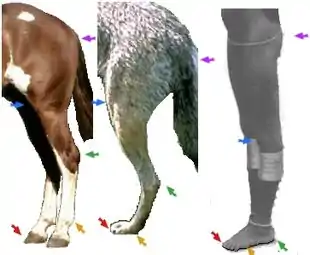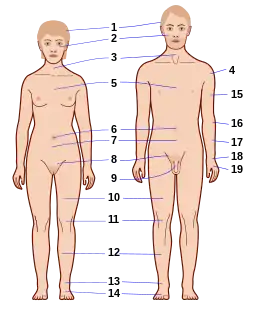kāja
Latvian
| Picture dictionary | |||
|---|---|---|---|
|
Etymology
From Proto-Baltic *kāy-a, from Proto-Indo-European *kāi-, a stem of unclear origin. It is possible that the initial *k is an irregular reflex of an earlier *gʷ, in which case Latvian kāja and its cognates might be derived from Proto-Indo-European *gʷā- (“to come, to go”); compare Latvian kāja : gāja (“he went”) with Sanskrit कायः (kā́yaḥ, “body, flesh”) : गयः (gājaḥ, “gait, motion”). Another hypothesis suggests a connection between Latvian kāja and Ancient Greek κιεἴν (kieín, “to run”), κινεῖν (kineîn, “to move, too put in motion”), Latin cieō (“to move”). Cognate include Lithuanian koja, Sudovian kaj ([kāj(a)]), Sanskrit कायः (kā́yaḥ, “body, flesh”).[1]
Noun
kāja f (4th declension)
- (anatomy) leg, foot (people's lower limb, organ of support and locomotion)
- spēcīgas, slaidas kājas ― strong, slender legs
- plata, maza kāja ― wide, small foot
- kāju pirksti ― toes (lit. leg/foot fingers)
- aut kājas ― to put shoes on (lit. to shoe (one's) leg/foot)
- atputināt kājas ― to rest one's legs/feet
- lēkāt uz vienas kājas ― to jump on one leg/foot
- kāju slauķis, kājslauķis ― doormat (lit. foot wipe)
- koka kāja ― wooden leg (primitive prosthesis)
- no galvas līdz kājām ― from head to toe (lit. to leg/foot)
- viņam veiklas, vieglas kājas ― he has agile, light legs (he walks easily)
- spēlēt futbolu bez kāju sargiem ir diezgan bīstami ― to play football/soccer without leg protection is quite dangerous
- Juris kādu rītu uzāva kājās garos, melnos zābakus ― every morning, Juris put long, black boots on (his feet)
- mežā pavisam tumšs... mēs ar Ati ejam lēni, taustīdamies, kājas augstu celdami ― in the forest it was dark... Atis and I walked slowly, gropingly, lifting (our) legs high
- (anatomy) leg, foot (corresponding organ in animals)
- zirga kāja ― horse's leg
- dzērves kāja ― crane's leg
- zirneklis ar garām kājām ― a spider with long legs
- (in the locative, used adverbially) standing on one's feet; up (awake)
- celties, lēkt, stāvēt kājās ― to stand up, to jump, to stand on one's feet
- suns uzslējās kājās ― the dog sat on (his) legs
- viņš šorīt agri kājās ― he (is) up early this morning
- (in the instrumental plural, used adverbially) on foot, walking
- iet kājām ― to go on foot
- viņš devās uz māju kājām ― he went home on foot
- footwear (usually while being worn)
- lai noslaukot kājas... ― in order to wipe (their) shoes,...
- meitene nokrata salijušo lietussargu, notīra dubļainās kājas ― the girl shakes the rained-on umbrella, cleans the muddy shoes
- (on objects) leg (a support similar to a human or animal leg)
- galda kāja ― table leg
- gultas kāja ― bed leg
- vēl te bija seši krēsli ar liektām kājām, apvilkti ar zaļu zīdu ― there were still six chairs with curved legs, upholstered in green silk
- šampanieša glāze var būt vai nu augsta un šaura, vai arī lēzena, bet uz augstas kājas ― a champagne glass may be either tall and narrow or flat, but (it has always) a long leg
Usage notes
Latvian kāja, refers both to a person's entire leg and more specifically to a person's foot; context usually clarifies which interpretation is best. It is the most frequent term in both senses. The word pēda, though sometimes translatable as “foot,” refers more specifically to the sole of the foot (and also to footprints). In the sense of "footwear", kāja (usually plural: kājas) is less frequent than apavs.
Declension
Derived terms
- kājām
- kājnieks, kājniece
Related terms
- kājot
References
- Karulis, Konstantīns (1992), “kāja”, in Latviešu Etimoloģijas Vārdnīca (in Latvian), Rīga: AVOTS, →ISBN



